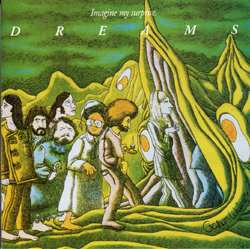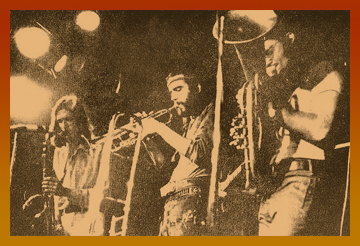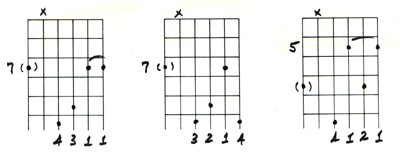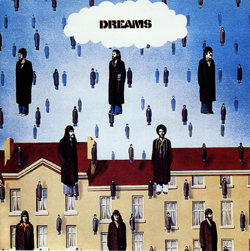

|
Soundclip:
|
| See Steve's Hand-Written Solo
Transcription |
|
Michael Brecker's solo on: "Child of Wisdom"(Jerry Friedman) Though I am probably not the best source for all the stories concerning the Jazz-Rock Fusion band, DREAMS and its brief but significant history, I do feel that I can convey some partial truths about them. As it is with most groups, Dreams began with the two songwriters, Jeff Kent(keys, guitar & vocals) and Doug Lubahn(el. bass & vocals). I am not certain just when lead vocalist Eddie Vernon entered the picture, but he was certainly the 'voice' of the group.  Now, how the horn section of Randy Brecker, Michael Brecker, and Barry Rogers became involved? Honestly, I can't recall. But, after a recent exchange of messages with my dear friend, drummer, Billy Cobham, he told me that Barry Rogers actually invited him to join the group. And so, there they all were! And, when their first album was recorded in 1970, John Abercrombie was added on lead guitar. So, that was a pretty formidable line-up, wouldn't you say? Now, how the horn section of Randy Brecker, Michael Brecker, and Barry Rogers became involved? Honestly, I can't recall. But, after a recent exchange of messages with my dear friend, drummer, Billy Cobham, he told me that Barry Rogers actually invited him to join the group. And so, there they all were! And, when their first album was recorded in 1970, John Abercrombie was added on lead guitar. So, that was a pretty formidable line-up, wouldn't you say?As time went on, as it is with all groups, some friction developed, and, of all things, I suppose it could be said that there was an internal "coup" of sorts, and Jeff and Doug were ousted from the band. Rather strange, considering that their songs made-up the core of the group's material. And so, in 1972, as the 2nd album was rapidly approaching, with the legendary Steve Cropper to produce, new band members appeared. Once again, you will see some very familiar names to this 'family' of players: Don Grolnick(keys), Bob Mann(guitar) and a very young and new to New York, Will Lee(el. bass & vocals). If you look at the fantastic Gahan Wilson cover drawing for "IMAGINE MY SURPRISE," you will see all of the band members, new and old, in caricature with one figure already half-entered into the mouth of the 'monster.' That is supposed to be the figure of Billy Cobham, who decided to leave the band, and join forces with the Mahavishnu Orchestra. In truth, conspiracy theories aside, that departure really spelled "d-o-o-m" for the group. I remember that they auditioned practically every available drummer in New York, and when that search was exhausted, they even flew in some well-known drummers from other parts of the country. In the end, they were never truly happy with anyone after Billy had left. His particular talents and feel were just too hard to replace. And so, this became their last recording. The dynamics of the relationship between the two Brecker brothers, Randy and Mike, is really a wonderful one, and a fascinating one on many levels. Over the years, since my arrival in New York in 1970, I have had the privilege of spending a great deal of time with them both, together, and separately. In most ways, Randy has always been the one with the more keen eye turned towards the business aspects of music, and Mike has always been the "artiste." Hence, there has always been a bit of a fundamental conflict there, but, the power and influence of the older brother, Randy, usually seemed to win out. Sitting here now, I can't recall just why I decided to transcribe this one little solo of Mike's which appears on guitarist Jerry Friedman's tune, "Child of Wisdom" but, when Mike's solo first appears, I could only sit here now and laugh, and imagine what was going through Randy's mind, on some level. The tune is very funky, and for a group like this, one could possibly say that it could have been considered as a 'single'!!! Well, the moment that Mike's solo begins, all such thoughts are put to rest. The song, as a hit single, is dead!!! In a sense, that was part of the beauty of Dreams, the horns would stretch the boundaries of the possible within a Rock or R&B context and this was supposed to have been accepted by the mainstream - and, at the time, there was still such a thing as "Free-Form FM Rock Radio" - so these genre-expanding groups could actually get played on the radio alongside legitimately more commercial group of that time and still be heard by millions of fans. It was, in truth, a great moment for music. And to me, it served to prove that if people are given the opportunity to hear music that they might not normally hear, many of those same people will actually respond to it, and then, buy it!!! But, this renegade radio format did not last nearly long enough, and much of the fringe music that they once played disappeared from the airwaves. If we take a closer look at the construction of "Child of Wisdom" the first thing we notice is that it is 5:22 in length, probably a good minute-and-a-half too long to be a single! It begins with Don Grolnick's solo piano introduction with a decidedly D7 Funk-R&B feel to it, which, as it begins, can make you feel that the groove is backwards,  turned around, until Billy Cobham comes in, and then you can hear where '1' was, and is!!! But, the seeds of harmonic subversiveness come into play quickly when the horns enter, and the 2nd-half of their first figure contains a lick with these final groupings: Gb(F#)-F-Eb - Db-C!!! In a D7 funk area, obviously F# is still the major 3rd, in truth, a very 'vanilla' note choice, but, Randy always liked to hit that note first and then go down to F-natural the 'blue note.' Still that approach is not really that "out" there, but, hearing Eb and Db, even going by quickly, something should sound a little 'different' to most ears. These are the interesting little harmonic touches that Dreams was trying to introduce to the genre. The principle vocal section of [A] remains over the D7 groove, and I would label the 2nd section as [B] which moves down to a B7 area with the same groove. Finally, there's a 6-bar [C] section with a simple but classic progression: Em-D/F#-G. In essence, that is the meat of the song. turned around, until Billy Cobham comes in, and then you can hear where '1' was, and is!!! But, the seeds of harmonic subversiveness come into play quickly when the horns enter, and the 2nd-half of their first figure contains a lick with these final groupings: Gb(F#)-F-Eb - Db-C!!! In a D7 funk area, obviously F# is still the major 3rd, in truth, a very 'vanilla' note choice, but, Randy always liked to hit that note first and then go down to F-natural the 'blue note.' Still that approach is not really that "out" there, but, hearing Eb and Db, even going by quickly, something should sound a little 'different' to most ears. These are the interesting little harmonic touches that Dreams was trying to introduce to the genre. The principle vocal section of [A] remains over the D7 groove, and I would label the 2nd section as [B] which moves down to a B7 area with the same groove. Finally, there's a 6-bar [C] section with a simple but classic progression: Em-D/F#-G. In essence, that is the meat of the song.As I always must do, this solo is written out in concert key, and, as this site is predominantly visited by guitarists, it is written in the written register of the guitar. This also conforms to the written register of the tenor sax. Obviously, if one is a saxophonist, you would have to transpose the solo up a whole-step. My apologies for that. The solo section, for Mike's tenor sax, appears after the 2nd time for [C], but the main 16-bar section for the solo is now played over an Am/B sonority, which for most of us would indicate a B Phyrgian[B, C, D, E, F#, G, A] area. I choose to view as A Dorian[A, B, C, D, E, F#, G] over 'B' in the bass. As you can see, they are really both the same and derived from the key of G major. I suppose, in terms of being connected to the song and what has appeared before, this could all be connected to the basic [B] section over the B7 groove. From the perspective of the rhythm section, the volume comes down for the 1st 8-bars and the harmonic tension created by this Phrygian sonority does all the work. At bar 9, [A2], you can hear that Billy Cobham goes to the bell of the ride cymbal and the intensity picks up. This all leads to rejoining the song form as Mike plays over what is really lettter [C] of the actual song. For notating the solo, I simply used [A] and [B], and then [I] for the Intro figure over which Mike continues to play until Eddie Vernon's vocal pick-up as he anticipates beat 2 of the 4th bar. And, in doing so, pretty much obscures Mike's final phrase!!! For those guitarists who might not have explored improvising over Phrygian sonorities, I have provided below 3 very basic chord grids that would immediately capture this sound for you, and your group. I have indicated for them to be played in B Phrygian, or A minor sounds over a B-pedal. Of course, you will get the best of ideas of these sounds if your bassist keeps it simple and plays a lot of B's! O.K.? I hope that this helps! 
This particular solo represents at least two important areas of Michael Brecker's influences. Throughout, you can clearly hear the Jazz side of his playing, but he also clearly references all his blues and R&B leanings as well. Of course, even against the Phrygian sounds of Am/B, you can easily employ the blues scale as it relates to 'B' as a root[B, D, E, F, F#, A]. If you look at the notes upon which Mike chooses to place the most emotional emphasis, in general, you can see that those notes are drawn from the blues language. For example, during [A], there is the low 'A' in bar 1; the 'E' in bar 3; the B-A at the end of the phrase in bar 5. As [A2] arrives and the intensity picks up, a heavier emphasis is placed on his higher register and B-D. In bar 5 of [A2], he vaults to a very high 'A' and holds it, before descending down to a 'B.' As you can see, the notes that I have pointed out all conform to notes within the B-blues scale. And, what you should take away from this is the emotional power of the blues and those very simple notes. When letter [B] arrives, Mike goes for a much more R&B oriented approach. Perhaps Mike was drawing on the two great exponents of this style during that period, King Curtis and Jr. Walker? To do this, in the most effective and evocative manner, you could probably rely upon two common devices. [1] Would be to put to use the B minor pentatonic scale[B, D, E, F#, A]; and [2] Would be to use the D blues scale[D, F, G, G#, A, C]. For the pick-up into the section, Mike vaults right up a Bm7 arpeggio which is certainly derived from option [1]. From the end of bar 2 through the midway point of bar 5, this is all option [2]. Through the end of this brief section he stays in the bluesier areas and, of course, over the [I] vamp, he remains there with lots of funky phrases emphasizing the blue note of 'F'. It should never be overlooked that during this period of his life, Mike Brecker became fascinated with the electric guitar, and all its bent notes. Whether it was Jimi Hendrix, or the great Albert King, Mike was interested in just how he could apply that kind of raw emotion to the saxophone. During this solo, you can hear a lot of that coming to the fore. For example, during [A], the high C# at the end of bar 4; and, the G-G# moments in bars 6-7. Finally in bar 2 of [I], he bends an 'E' up to an 'F'. As I have mentioned the G# and the emphasis that Mike placed on that note for a moment, I would want to point out that over such a Phrygian sound, you often hear the great players employing what I would can A melodic minor[A, B, C, D, E, F#, G#] over the B-pedal. This is a one note change from A Dorian. Meaning that the G-natural now becomes G#. There is also another moment in the solo, at the end of bar 6 of [A2], on beat 4, Mike places a lot of emphasis on a high C#. This particular note does not 'fit' into any of the improvisational options that I have offered here. Within B Phrygian, it is a note that is in between C-natural and D-natural, and, in a sense, it should not sound good. But, surely it does. Some of that is just a by-product of playing that particular note with supreme confidence. From that factor alone, the note becomes absolutely believable and emotionally moving. At least, it is to me. You, of course, must decide for yourself. If we are to attempt to dissect the Jazz-oriented elements of the solo, sometimes it is instructional to look for any long passages that might involve scales, modes, or even arpeggios. But, as this solo is really only 16-bars in length, there is really not much offered in that regard. However, you do have one long line that extends from the pick-up bar into bar 1 of [A]. When trying to analyze passages like this, at times, it is not clear, because one tries to adhere to the notation standards for descending or ascending lines. Meaning that, one should use flat signs when descending, and sharp signs when ascending. This first line begins on a high G-natural, and concludes on a low A-natural. Certainly the last note is consistent with being a part of B Phrygian. However, in between, it appears to me that Mike is implying an area of Bb7, with some chromaticism. If you look at the chords, you can see that there a big accent on a C chord, almost like a power chord, meaning that there is not much emphasis on a 3rd, major or minor. So, if one was passing from C through Bb7 down to Am/B, this makes good harmonic sense. Think about that! The 2nd long line is really more of the arpeggiated variety, and it appears in bar 15 of the solo. I have spoken about that high C#, which I suppose that one could spell as Db, and after that, the line descends all the way down to a low Ab.  Along the way, I really see and hear two distinct Bb augmented triads(Bb-D-F#). The first note, after that high C#, was really hard to hear. There were moments when I thought that it was a Bb, or a C-natural, but I finally felt that I really heard it as A-natural. If so, the first part of the passage, A-G-F#, could easily be seen as being part of B Phrygian. Anything having to do with the area of Bb7 could be seen as passing from the B-blues area down to Am7/B. Along the way, I really see and hear two distinct Bb augmented triads(Bb-D-F#). The first note, after that high C#, was really hard to hear. There were moments when I thought that it was a Bb, or a C-natural, but I finally felt that I really heard it as A-natural. If so, the first part of the passage, A-G-F#, could easily be seen as being part of B Phrygian. Anything having to do with the area of Bb7 could be seen as passing from the B-blues area down to Am7/B.In general, this short solo features a great deal of arpeggios, small ones, and some jagged intervallic moments as well. So, if we are to accept that, I think that it would be a good idea to see just how many of these arpeggios could be related to A minor in one form or another. So, beginning with [A], in bar 2, from beat 3 into beat 4, you see a D triad as Mike returns to more consonant sounds. In bar 4, a B minor triad is essentially outlined. During [A2], in the 2nd-half of bar 3, you see a C triad, which could easily be considered as part of Am7, and then a D triad. On the first beat of the next bar, there appears to be a reference to a simple Am triad. I would also want to mention that Mike takes advantage of the full register of his instrument during this brief solo as he hits his lowest Ab, and goes as high as a stratospheric 'A'. I have always especially loved the sound of his lower register. It is undeniably true that one of the most appealing aspects of Michael Brecker's playing is his fantastic sense of time. As "Child of Wisdom" relies on an insistent, relentless quarter-note pulse from the rhythm section, it gives Mike something to really dig into. Notice how often the first note in any 16th-note grouping is accentuated. If you look carefully, it is most interesting to note that most times that accentuated note is actually consonant within the tonality of B Phrygian. The note most often played "outside" of that harmonic zone is an Eb, appearing 3 times that I can see. I could never close this analysis without saying something further about the fantastic cover art for both Dreams LPs/CDs. Of course, during the '60s and '70s, a powerful record label like Columbia Records was much more willing to pay for such original artwork. The cover art for their first recording is obviously a parody of one of the most famous paintings by the Belgian surrealist, René Magritte which is titled, "Golconde" from 1953. To me, this is one of the great, great LP covers of all time!! Classic!! Of course, some of you might be curious as to just how the musicians in the group appear in the drawing so, here we go: Top Row: Billy Cobham - Randy Brecker - John Abercrombie Middle Row: Jeff Kent - Eddie Vernon Bottom Row: Michael Brecker - Barry Rogers - Doug Lubahn As I previously mentioned, the original cover art for "IMAGINE MY SURPRISE" was done by the wonderful Gahan Wilson. Many of you should be familiar with his ghoulish work and style through his monthly cartoons for "PLAYBOY" magazine. I have a book of these cartoons, and they're still hysterically funny to me. If you are wondering who's who in this drawing, I'll identify the guys for you, from left to right: Michael Brecker, Randy Brecker, and Barry Rogers. Then, just below Barry, is Don Grolnick, dressed as a friar!!! Finally, you have Eddie Vernon, Bob Mann, and Will Lee. I can't stop laughing at how much Don hated how he was portrayed in this drawing! Perhaps Don did not want to be cast in the role of "Friar Tuck" in a future production of "ROBIN HOOD"? As the year of 2009 comes to a close, and we are about to welcome the arrival of 2010, our hopes are again renewed, and let us see what the new year brings! We want to take this opportunity to wish everyone a very MERRY CHRISTMAS and a ¡FELIZ NAVIDAD! And, of course, now it is time to finally say, yet again, HAPPY NEW YEAR!!! Y por supuesto, les deseamos un muy ¡FELIZ AÑO NUEVO! Wishing you all good health, happiness, and again, the annual plea for PEACE everywhere!!!
[Photo of Randy Brecker, Michael Brecker & Barry Rogers w/ Dreams ca. '70
Photo courtesy of the: Jeff Kent Archives] |